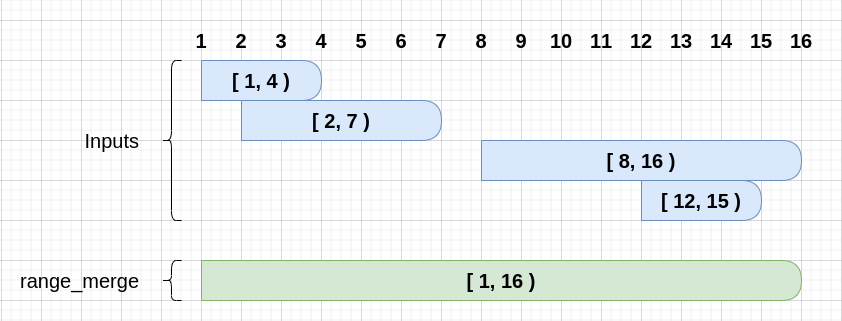# django-range-merge
Enables the `range_merge` Aggregate for Django on Postgres. `range_merge` "Computes the smallest range that includes ... the given ranges".

This package should only be used with Django projects using the Postgres database. See [Postgres docs on Range Functions](https://www.postgresql.org/docs/14/functions-range.html#RANGE-FUNCTIONS-TABLE).
Note: This app is still a work-in-progress, but currently works. Tests have not yet been implemented.
## Installing
Add to `INSTALLED_APPS`:
```python
INSTALLED_APPS = [
...
"django_range_merge",
...
]
```
Migrate to apply the aggregation to your database:
```bash
> python manage.py migrate
````
## Getting Started
Here is a quick example. We have an `Event` model with two different range fields: `period`, which contains the datetime range period during which the Event occurs; and `potential_visitors`, which is an approximation of the minimum and maximum number of people attending the Event.
We want two different views to help Event organizers understand some aggregate details about Events.
- **range_of_visitors_this_month**: Show the overall lowest and greatest number of people we expect for all events this month
- **overall_dates_of_funded_events**: Shows the overall range of dates for Events which are funded (the `is_funded` BooleanField is set to True)
models.py
```python
class Event(models.Model):
name = models.CharField(max_length=30)
period = models.DateTimeRangeField(help_text="The period of time this event covers")
potential_visitors = models.IntegerRangeField(help_text="The range of visitors expected at this event")
is_funded = BooleanField(default=False)
class Meta:
verbose_name = "Event"
verbose_name_plural = "Events"
def __str__(self):
return self.name
```
date_utils.py (get a range covering the entire current month)
```python
from django.utils import timezone
from dateutil.relativedelta import relativedelta
from psycopg2.extras import DateTimeTZRange
def get_month_range():
"""Return a DateTimeRange range covering this entire month"""
today = timezone.now().date()
if today.day > 25:
today += timezone.timedelta(7)
this_month_start = today.replace(day=1)
next_month_start = this_month_start + relativedelta(months=1)
return DateTimeTZRange(this_month_start, next_month_start)
```
views.py
```python
from django.db.models import F, Aggregate
from django.template.response import TemplateResponse
from .date_utils import get_month_range
def range_of_visitors_this_month(request):
"""
e.g., given the following instances:
{"id" : 1, "name" : "Birthday", "potential_visitors" : "[2, 3)", ...}
{"id" : 2, "name" : "Bake Sale", "potential_visitors" : "[30, 50)", ...}
{"id" : 3, "name" : "Band Camp", "potential_visitors" : "[22, 28)", ...}
{"id" : 4, "name" : "Cooking Show", "potential_visitors" : "[7, 20)", ...}
{"id" : 5, "name" : "Pajama Day", "potential_visitors" : "[15, 30)", ...}
The result would be:
{'output': NumericRange(2, 50, '[)')}
"""
template = "base.html"
context = Event.objects.filter(period__overlap=get_month_range()).aggregate(
output=Aggregate(F("potential_visitors"), function="range_merge")
)
return TemplateResponse(request, template, context)
def overall_dates_of_funded_events(request):
template = "base.html"
context = Event.objects.filter(is_funded=True).aggregate(
output=Aggregate(F("period"), function="range_merge")
)
# Example result: {'output': DateTimeRange("2022-10-01 02:00:00", "2022-12-07 12:00:00", '[)')}
return TemplateResponse(request, template, context)
```
base.html
```html
<html>
<head></head>
<body>
{{ output }}
</body>
</html>
```
## License
The code in this repository is licensed under The MIT License. See LICENSE.md in the repository for more details.
## Contributing
Contributions are very welcome.
This project is currently accepting all types of contributions, bug fixes,
security fixes, maintenance work, or new features. However, please make sure
to have a discussion about your new feature idea with the maintainers prior to
beginning development to maximize the chances of your change being accepted.
You can start a conversation by creating a new issue on this repo summarizing
your idea.




